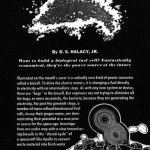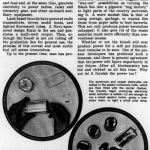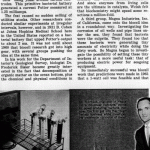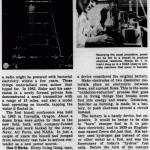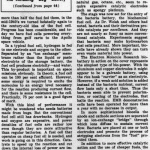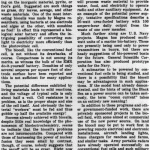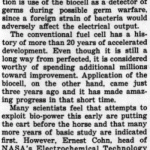THE AMAZING “BUG” BATTERY
Want to build a biological fuel cell? Fantastically economical, they’re the power source of the future
Illustrated on this month’s cover is a radically new kind of power converter called a biocell. To drive the electric motors, it is changing a fuel directly to electricity with no intermediate steps. As with any new system or device, there are “bugs” in the biocell. But engineers are not trying to eliminate all the bugs, or more accurately, the bacteria, because they are generating the electricity. Far past the gimmick stage, a number of more refined biochemical fuel cells, to use their potential as a new power source for the space age. Investigations are under way with a view toward using biocells in the “closed-cycle” of a spacecraft like Apollo to convert waste material into fresh water and food and, at the same time, generate electricity to power radios, radar and telemetry gear, and other on-board auxiliary equipment.
Land-based biocells have powered radio transmitters, driven model boats, and lighted fluorescent tubes. A Navy-sponsored design floats in the sea and generates a multi-watt output. Thus, although the biocell is not yet rolling of the production line for general use, the promise of this newest and most exotic fuel cell seems tremendous.
Up to the present time, man has produced the electricity he uses by mechanical or electrochemical means. Biochemistry now looms as a major producer of power for us, and it is not the science-fiction or Sunday supplement writers but scientists themselves who suggest such “way-out” possibilities as turning the Black Sea into a gigantic “bug battery” to light parts of the country surrounding it. A more modest idea is that of using sewage, garbage, or wastes like those from paper mills to feed bacteria. This not only produces power heretofore untapped; it also gets rid of the waste material much more efficiently than conventional means.
Whether or not the biocell will ever produce power for a mill per kilowatt-hour remains to be seen. One of the pioneer developers has predicted such a bonanza and there is general agreement that bio-power will figure importantly in our future. After all, biochemistry has fed and clothed us all this time. Why not let it furnish the power too?
The Biocell’s Past
Although even the ancient Romans were aware of electricity in living things and actually used the torpedo ray fish in shock treatment of the mentally ill, the idea of putting bacterial metabolism to work as an electrical power plant dates back only about 50 years. In 1912 a British botanist, M. C. Potter, put together a half-dozen “cells” using yeast around carbon electrodes. The primitive bacterial battery generated a current Potter measured at 1.25 milliamps.
The feat caused no sudden selling of utilities stocks. Other researchers conducted similar experiments at irregular intervals, however, and in 1931 B. Cohen at Johns Hopkins Medical School here in the United States reported on a bacterial battery that upped Potter’s output to about 2 ma. It was not until about 1960 that biocell research got into high gear, with several groups pushing the idea at the same time.
In his work for the Department of Interior’s Geological Survey, biologist Dr. Frederick Sisler became greatly interested in the fact that decomposition of organic matter on the ocean bottom, plus the chemical and physical conditions in the ocean, led to production of a weak electric current. He began to work toward developing a biocell exploiting this phenomenon.
Dr. John Welsh and his associates at Joseph Kaye and Company, a Cambridge, Massachusetts, research firm, noted that all fuel cells had certain common denominators – fuel, plus a catalyst to accelerate the electrochemical reaction. And since enzymes from living cells are the ultimate in catalysts, Welsh felt that biochemistry might speed some reactions a million-fold.
A third group, Magna Industries, Inc. of California, came onto the biocell idea in a roundabout way. Investigating the corrosion of oil wells and pipe lines under the sea, they found that bacteria were the culprits. They found too that these bacteria were generating tiny amounts of electricity while doing the dirty work. So Magna began to investigate the possibility of setting these tiny workers at a more useful task: that of producing electric power for seagoing equipment.
So immediately successful was biocell work that predictions were made in 1961 that a 1-watt cell was feasible and that a radio might be powered with bacterial electricity within a few years. These things materialized even sooner than hoped for. In 1962, Sisler and his associates in a newly formed private firm demonstrated a small transmitter with a range of 15 miles, and also a model boat operating on biocells, tapping the water it floated in.
The first biocell conference was held in 1962 in Corvallis, Oregon. About a dozen firms were active by then in the new field, both with company-funded studies and work backed by the Army, Navy, Air Force and NASA. In just a couple of years the biocell had jumped from laboratory test tube to serious contender as a new power source.
How It Works
Every living thing, man, mouse, or microbe, is a biochemical fuel cell. It takes in food or “fuel” and breaks the material down to a lower form, extracting energy in the process. Some of this energy appears in the form of electricity. Luigi Galvani was intrigued by the animal electricity he found in frogs, but his countryman, Volta, turned scholars of electricity in another direction with his Voltaic pile, a device considered the original battery.
Make electrodes of two dissimilar materials, place an electrolyte between them, and current flows. This is the same “oxidation-reduction” process that goes on in living things that breaks down fuel into energy and waste. Oxidation, familiar as burning, is made in a battery to push electrons around a circuit instead.
The battery is a handy device, but expensive. It would be better to be able to “burn” cheaper fuel in it to produce electricity, and in 1839 an Englishman named Grove did just that. His battery used hydrogen gas instead of zinc or other metal as fuel, and was the forerunner of today’s “hydrox” fuel cells. Before the turn of the century other workers had improved Grove’s idea and coined the name “fuel cell”. But another means of generating electricity was making its debut. Called the dynamo, it ushered in the age of the mechanical production of electric power.
Since even the most efficient turbine generators are doomed by the inexorable laws of thermodynamics to waste (Continued on page 103)
In a typical fuel cell, hydrogen is fed to one electrode and oxygen to the other. Separated by an “ion exchange” membrane rather than the liquid or paste electrolyte of the storage battery, the fuel cell produces electricity – and water. This by-product is important on space missions, obviously. In theory, a fuel cell can be 100% efficient. However, some energy is required to excite the molecules to an energy level necessary for the reaction producing current flow, and there is some resistance in the cell. Practically, 75% is a good figure of merit.
With this kind of performance it might be wondered who need batteries made from bugs. But the conventional fuel cell still has drawbacks. Hydrogen and oxygen are expensive, and power densities of fuel cells are rather low even though they are more attractive than regular batteries. A fuel cell that operates on cheap fuel oil is needed and work is going on in this direction. Catalysts to speed up the reaction and cut down the internal loss of power are important. Such things as platinum, and more recently, nickel boride, are being used. Unfortunately, fuel cells using inexpensive hydrocarbon fuels such as natural gas, octane, etc., seem to require expensive catalytic electrodes such as spongy platinum.
The stage was now set for the entry of the bacteria battery, the biochemical fuel cell. As Dr. Welsh and others had noted, bacteria and their derivatives provide catalysts par excellence. And they are not nearly so fussy as more conventional catalysts. Experiments suggest that bacteria may make hydrocarbon fuel cells practical. More important, biocells have already shown they can turn even waste material into power.
The Electron Molecule Research bio-battery in action on the cover represents the simplest type of bio-power. With its aluminum and copper electrodes it might appear to be a galvanic battery, using the rice husk “carrier” as an electrolyte. However, if a weak acid solution is added instead of the bacteria nutrient, current flow lasts only a short time. Thus the bacteria seem able to prevent polarization, or coating of the electrodes, that halts the reaction. EMR demonstration cells have been operated for more than a year with no decrease in output.
In more sophisticated biocells the anode and cathode sections are separated by an ion-exchange “bridge” through which ions diffuse to sustain current flow. Bacteria are placed at one or both electrodes and promote the process of stripping electrons form the “fuel” provided them.
In addition to more effective catalytic action and the use of cheaper fuels, the biocell operates at room temperature rather than high temperatures required in some fuel cells. It is also characterized by the mild, “natural” conditions at which life processes take place, with a pH factor in the neutral range and a dilute water solution as an electrolyte.
Fuel for the biocell varies from sugar to organic sea material, yeast, mushrooms, or urea. The U.S. Bureau of Mines has demonstrated a biocell operating on the inorganic material, pyrite, or fool’s gold. Suggested are such things as grass, dry leaves, sewage, and other waste materials. One of the most interesting biocells was made by Magna researchers, using bacteria at one electrode and algae at the other, with sunshine as fuel! In effect this represented a biological solar battery and offers the intriguing possibility of converting sunlight to electricity more efficiently than the photovoltaic cell.
The biocell, like the conventional fuel cell, is not without its drawbacks, of course. Compactness is not among its merits, as witness the bulk of the EMR do-it-yourself battery. Densities of only several amperes per square foot of electrode surface have been reported and this is not sufficient for many applications.
The potential difference exhibited by living materials leads to mild reactions, and the voltage of typical cells is only about half a volt. Cell resistance is a problem, as is the proper shape and size of the cell itself. And obviously the bacterial “workers” must be fed and thus gobble up half the available energy!
Success already achieved with biocells, despite little real knowledge of the phenomenon of bioelectrochemistry, seems to indicate that the biocell’s problems are not insurmountable. Compared with those of harnessing the power of nuclear fusion they seem small by contrast, though, of course, nobody suggests that the payoff will be as great. Right now researchers know that the biocell works; they want to know how to make it work better and the chances are good that they will succeed.
Biocells – Today and Tomorrow
Space planning is helping to boom biocell development. When NASA asked for bids on a project there were 33 responding firms. Contracts have gone to four of them and working systems may be part of manned space vehicles within several years. This is the “Space Oasis” concept, referred to before, with biocells working in conjunction with an algae solar converter in the spaceship’s closed cycle. Magna Corporation, Marquardt Inc., General Electric and Ford’s Aero-nutronic Division are doing such research work for NASA.
In operation, such a closed-cycle plant will process waste material to provide water, food and electricity to operate radio and other auxiliary equipment. As an example of the potential power supply, tentative specifications describe a 20-watt urea-fueled battery with 100 ampere-hour daily output from the waste of one member.
Much farther along are U.S. Navy projects. Magna has produced multi-watt units of a marine bio-battery. These are presently being used only to power transmitters in buoys, but there are heady suggestions of bio-powered boats for the future. General Scientific Corporation has also produced prototype units for the Navy.
A submarine to be powered by conventional fuel cells is being studied and there is a possibility that the biocell may be advantageous in such applications. If the model boat already demonstrated and the hints of using the Black Sea as a power source can be taken seriously, the term “ocean current” takes on an entirely new meaning!
In addition to these programs and other government-funded work, there are privately sponsored projects in the biocell field, with some aimed at commercial use of the new power source.
On land biocell may be put to work first in powering remote electrical and electronic installations, aircraft landing lights, fence chargers for ranches and farms and similar tasks. Army portable radars have already operated successfully on conventional fuel cells and such military gear using bio-power seems possible.
Later on may come projects like harnessing the energy in sewage, paper mill effluent, and so on. While conventional generating plants are obviously safe for many years to come, developments in biochemistry may eventually lead to low-cost industrial electricity competing in some areas with that produced by fossil fuels.
More easily foreseeable are processes in which the biocell does a dual job. It has been pointed out that a brewery is a potential power plant if the heat of fermentation can be converted to electricity. The same might apply to a bakery and to other industries dependent on biochemical action.
The biocell may also prove of great value as a chemical process rather than a power producer. Since the fuel cell can work both ways, electricity might be supplied to the cell and the bacteria furnish useful by-products rather than electricity. Another interesting suggestion is use of the biocell as a detector of germs during possible germ warfare, since a foreign strain of bacteria would adversely affect the electrical output.
The conventional fuel cell has a history of more than 20 years of accelerated development. Even though it is still a long way from perfected, it is considered worthy of spending additional millions toward improvement. Application of the biocell, on the other hand, came just three years ago and it has made amazing progress in that short time.
Many scientists feel that attempts to exploit bio-power this early are putting the cart before te horse and that many more years of basic study are indicated first. However, Ernest Cohn, head of NASA’s Electrochemical Technology Projects, points out an interesting parallel in the chemical industry. While papers and theses are still being written describing original research on production of ammonia, we nevertheless have an excess of manufacturing capacity for the compound.
Not sure just how the biocell really works, scientists and engineers are nevertheless putting it to use. Given 20 years, it too may do some marvelous things. Meanwhile, you can put together a simple bio-battery of your own and watch or listen to, bug-power go into action!

